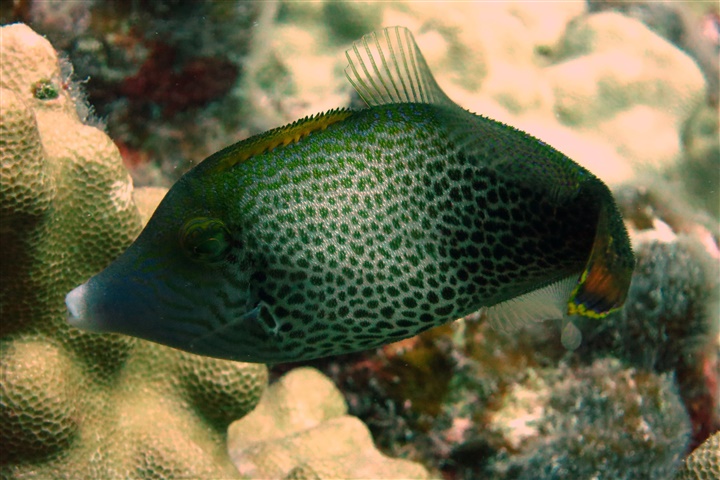Pervagor spilosoma

| Latin name | Pervagor spilosoma - (Lay & Bennett, 1839) |
|---|---|
| Local name | Fantail filefish |
| Family | Monacanthidae - Pervagor |
| Origin | |
| Max length | 18 cm (7.1") |
| Minimum volume |
700 l (185 gal) |
|---|---|
| Hardiness |
Hardy |
| Suitable for aquarium |
Suitable with care |
| Reef safe |
Reef safe with luck |
| Aggressiveness | Might be aggressive towards similar species |
| Recommended |
Macroalgea (Eg. seaweed / nori) Microalgea (Eg. spirulina) Small crustaceans (Krill, mysis, artemia...) |
|---|---|
| Maybee |
Large polyp stone coral (LPS) Larger crustaceans (Shrimp, crabs...) Other invertebrates Soft coral |
This species likes to eat tubeworms.
This species can be a threat towards small crustaceans, e.g. small shrimp.
This fish requires feeding several times a day, especially when newly added.
When the fish can find its natural food in the aquarium it requires less frequent feeding.
This species needs good hiding places, for example, between live rocks.
This species can be very shy when first introduced into a new aquarium.
More aggressive fish can be introduced after this species has acclimatized.
Filefish (Monacanthidae) have a very characteristic appearance, but whether one likes them or not is a matter of taste.
Some species are suitable for aquaria, although they will occasionally eat a coral or invertebrate. They are therefore not so well suited to coral tanks.
They are often used to fight glass anemones (Aiptasia) and Majano anemones. Pervagor nigrolineatus is especially good at this.
They need peace and quiet from both the aquarist and other fish, when adjusting to the tank life.
Be careful when catching them, as they easily becomes caught in the net.
| Aquarium trade | Yes |
|---|---|
| Distribution | Eastern Pacific: throughout the Hawaiian Islands, including the Leeward Group; rare in Johnston Island. |
| Danish common names |
Viftehalet filfisk |
| English common names |
Fantail filefish |
Henry C. Schultz. 2004. Files Not Meant For Your Toolbox (or Reef Aquarium!) - Reefkeeping Magazine - (English)
Dave Wolfenden. 2013. Filefish: A bit of rough! - Practical Fishkeeping - (English)
Scott W. Michael. Can You Add Filefish to a Reef Tank? - Fish Channel - (English)
Bob Fenner. Filefishes, Family Monacanthidae, Part I, Part II, Part III - Wet Web Media - (English)
Scott W. Michael. Those Fabulous Filefish - Tropical Fish Hobbyist Magazine - (English)

